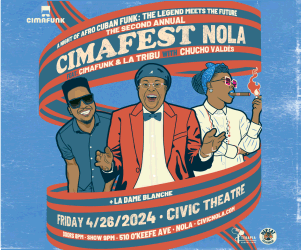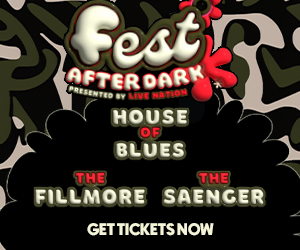Late in the day, a friend responded to a tweet about sitting through a mediocre Brooklyn band waiting for a Generationals set, “Can’t get enough of NOLA bands in NOLA?” Fair question, though he conceded that he was going to end his evening seeing Quintron and Miss Pussycat, so he was tracking the home side on the road much like I was. I want to know, though, how Louisiana bands travel. Do people get it? Is local indie rock good for New Orleans, but not necessarily up to the national standard?
The new version of MyNameIsJohnMichael played a day party at 1 p.m. yesterday at Antone’s, and even though it was a bit early for sing-alongs, the band had the crowd in constant motion. The dynamic was changed by the new lineup, particularly the addition of horns, which made the sound even bigger and more organic. Afterwards, John Michael Rouchell spoke of how the addition of horns was partially a response to the state of indie rock. “It’s dead,” he said. “It’s become its own genre.”
Later that afternoon, the Lost Bayou Ramblers opened the Carnival on S. Congress at the Continental Club, a party co-sponsored by a number of Louisiana entities and Bug Music. Recently, Tom Thayer of d.b.a. spoke of how the Ramblers had found a punk audience, something I could see but didn’t expect. The band’s core instinct has been toward rawness, and its model for how to move forward has usually involved looking way into history, but yesterday it was also clear that the Ramblers now hit harder than ever. Bassist Alan LaFleur and Cavan Carruth have always brought punk edge, but drummer Paul Etheredge doesn’t play like a Cajun drummer and pushes the songs in a rockier direction.
Susan Cowsill concluded her set at the Continental Club to call out “her new family,” the Hobart Brothers – Jon Dee Graham and Freedy Johnston – for an obviously unplanned version of “River of Love.” For a while, it wasn’t clear that the additional members were going to bring more than uncertainty to the version as Graham worked to find his place in the song and the mechanics at the microphone between bassist Sam Craft and Johnston kept anything meaningful from happening there for much of the song. But by the final choruses, things were rounding nicely into shape before Russ Broussard played a quick snare figure to feed the ending to Graham, whose lyrical lead at the end made the moment pay off.
It also set the stage for the the Hobart Brothers and Lil’ Sis Hobart show, which had everybody in the room looking at each other with disbelief – and maybe the band, too. They’re at SXSW drawing attention to their efforts to raise money through Kickstarter to put out the album the three recorded last year, At Least We Have Each Other, and when they performed on Wednesday, it was the first time playing together since the recording sessions and the first time ever with a rhythm section. With a few gigs under their belts, they were ready to bring the songs to life and move comfortably inside them. The show was loose in only positive ways, and Graham, Cowsill and Johnston have such distinctive, lived-in voices that harmonies add shades of meaning. At the show, Graham provided the best lyric of SXSW for me this year – “between the shallow and the grave” – and the best song, “Almost Dinner Time,” with an almost uncanny access to the details of youth without being maudlin. “There wasn’t an ounce of furious in that car,” may be the most backhanded expression of the good times ever, but it hints that the good times may not last.
Last local stop: the Cedar Street Courtyard to see Generationals, and I wasn’t alone. Most of the crowd showing up shortly before they started and streaming out afterwards. Ted Joyner and Grant Widmer still look like members of the Math Club – an impression that’s emphasized when Michael Girardot walks on stage to play trumpet looking like one of the cool kids in theater arts. Their reticence at center stage has a quirky appeal, but it also meant that people were there for the songs, not the show, and the band delivered. I hear new wave dance music in their pop, but it’s not so referential that the appeal is the music’s sonic resemblance to the ’80s. The clarity of musical thought is their hallmark – songs that seem to know what they’re about and stick to that thought, but lyrically and musically. Everyone around me was seriously into the show, including the one going throwing devil horns (gotta say, didn’t see that coming) and the guy who was ecstatic when he worked his way to the front midway through the set.
At that point, it was time to see music I can’t see by stepping out of our office and went to sit through the Cool Kids en route to Montreal’s Chromeo. Cool Kids – I really like them and enjoy any individual song, but live they moved so quickly from song to song that the set started to sound like one long, disjointed song, an issue amplified by the relatively spare beats – at times, nothing more than drum programming. Pittsburgh’s Mac Miller performed an unannounced set, and while I worry that rock music’s losing some of its aspirational nature – Who’d want to be in many of these bands? How would your life be any different? – every young, white, male, hip-hop fan in the room saw himself on the stage, rocking the party and living the high life. It was music for party gladiators, but you couldn’t miss how much more the audience was into him than the Cool Kids.
Unlike Generationals, Chromeo‘s entirely about retro sound, every song sounding like it could have been on a lost Madonna album circa “Into the Groove.” The two-man band delivered a lot more sound than the two of them were playing, but that was beside the point. You could hear their live contributions, and in a night that had been as much about the between-set music by production-and-DJ duo Classixx, the Chromeo sound and groove was what people came for. The one odd feature of the show was how, instead of stretching things out live, Chromeo brought almost every song to an early and slightly abrupt ending.




